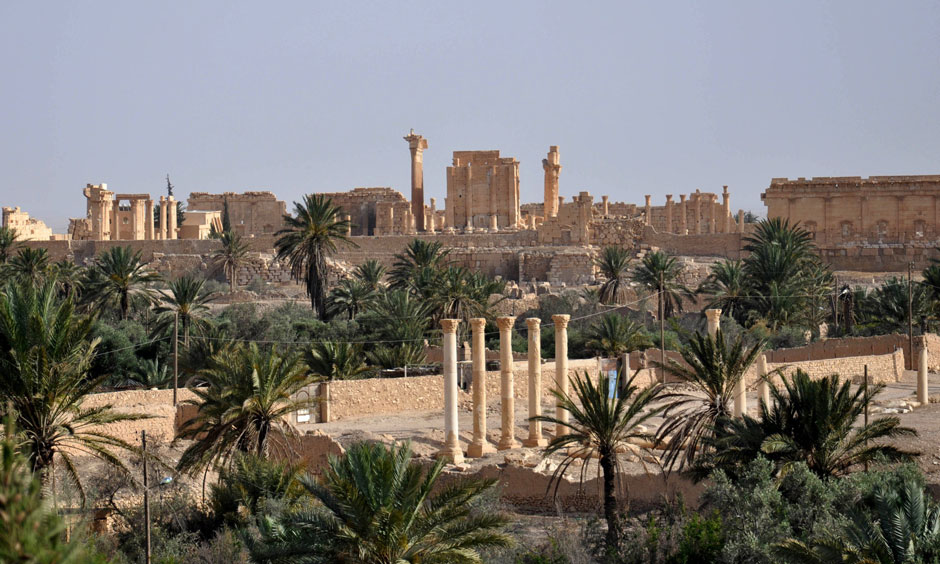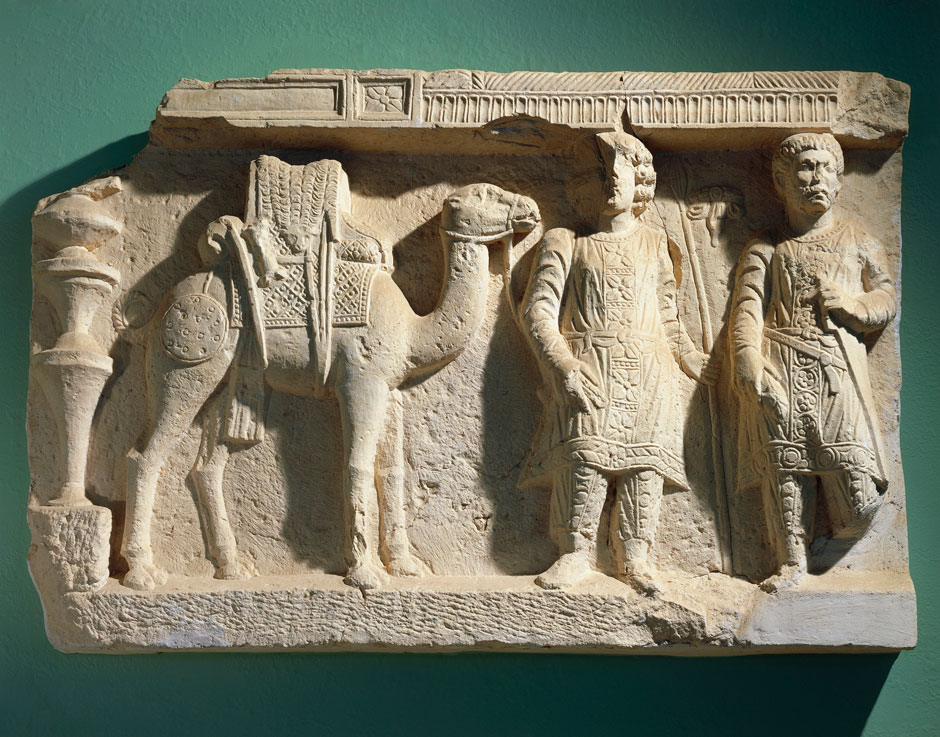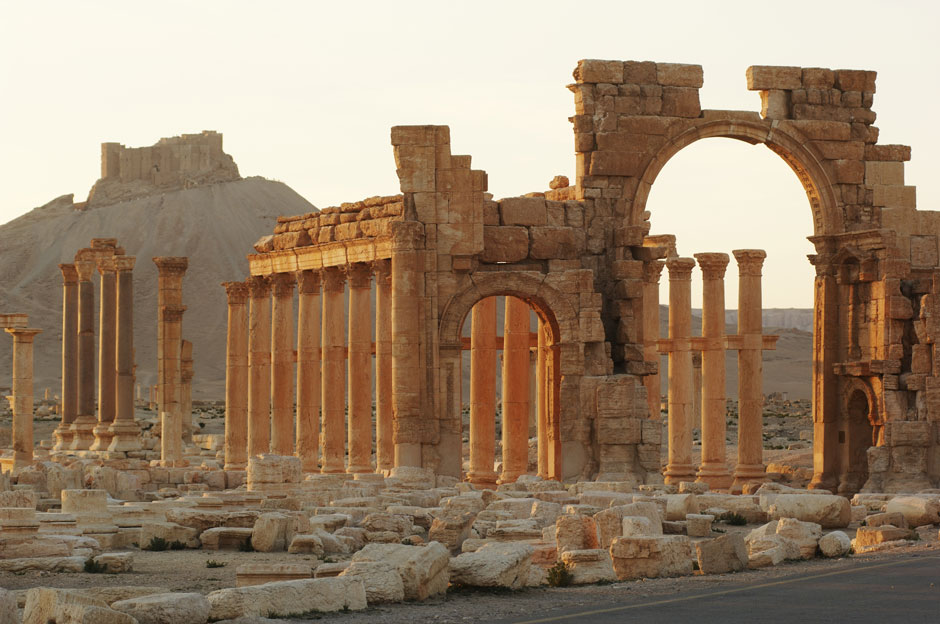The fall of the ancient city of Palmyra before the brutal forces of ISIS last week raises the terrifying prospect of damage that could potentially eclipse the recent destruction that the same organization has wrought, and savagely advertised through its videos, at Mosul, Nimrud, and Hatra in Iraq. As one of the most magnificent ancient cities in the Mediterranean world under Roman domination, Palmyra has survived until now with its imposing temples, colonnades, sculptures, reliefs, and mosaics to awe every visitor to the site since its dramatic expansion in the first century AD. It rises in splendor in the middle of the Syrian Desert, at an important oasis that was doubtless the reason for its existence in the first place. Among the great cities of antiquity Palmyra is comparable only to Petra in Jordan, Angkor Wat in Cambodia, and the Athenian Acropolis in Greece.
The Western world became aware of Palmyra through the exploration of two British travelers, Robert Wood and James Dawkins, whose book about their discoveries, with breathtaking illustrations, appeared in 1753. They published a panoramic view of the whole city, for which they included as a caption a famous phrase from the Roman polymath Pliny the Elder. He had written that Palmyra lay between two great empires, the Roman and the Iranian (Parthian in Pliny’s time but subsequently Persian), even though it was in fact a part of the Roman province of Syria. Its monuments had emerged from the late Hellenistic baroque, inflected by local Arab styles. Palmyra was, quite simply, exceptional.
It had been a city in the Syrian desert since the early second millennium BC, when it first appears under its Semitic name of Tadmor, a name traditionally associated with the Arabic tamr (“date”) but without any scholarly consensus about the etymology. The Roman name Palmyra evokes “date-palms,” although there is no way of telling whether this name was meant to reproduce Tadmor. Both these names turn up across four thousand years in a bewildering variety of texts in Akkadian, Aramaic, Greek, Latin, Arabic, and other languages. The city itself developed its own script for writing its native Aramaic, and it used this extensively in inscriptions alongside Greek, which was the lingua franca of the region under Roman rule.
Palmyra was a gateway to the west and the east, connecting the Mediterranean with Mesopotamia. As such, it became a city of merchants who linked up with traders from as far away as China. The Palmyrenes, though encompassed by desert on all sides, built ships and took to the water to access the Persian Gulf and the Indian Ocean by way of the Euphrates. Their reach extended as far as the island of Socotra, where they left an inscription in their own language. Only Petra had such an extensive caravan trade. Not surprisingly, merchants from both Petra and Palmyra encountered one another at a trading post called Forat at the head of the Persian Gulf.
In 1882 Russian visitors to Palmyra discovered a huge stone block with a bilingual inscription, dating from 137 AD, listing the taxes for various kinds of goods brought into the city. Although this is a strictly local document, it shows the diversity of commerce that passed through. It refers to the city, in both Greek and Aramaic, as a port or a harbor, but in the Roman sense of a fiscal area. For this reason Palmyra is today often called The Port of the Desert or more fancifully The Venice of the Sands. (The inscription, which is known as the Palmyra Tariff, was cut up into four pieces and transported to St. Petersburg with Ottoman authorization. At this moment it may be just as well that it was taken there.)
Those intrepid merchants of the desert set up many sculpted memorials of themselves and their achievements amid the grand temples. They proudly built their city for themselves and their families, not for the Roman emperors, although they enjoyed imperial patronage. The temples, civic buildings, and tombs are among the treasures of Palmyrene art, and they have endured for two thousand years. The reliefs on large funerary monuments show noble figures in grandiose attire, holding bowls at banquets for the dead. The women are wearing elaborate pearl necklaces. Palmyrene divinities keep company with friendly lions and eagles spreading their wings. The city’s merchants appear with their camels and sometimes with their ships.
The hellenization of the Middle East had come with Alexander the Great and was prudently maintained by the Roman authorities, for whom Latin was largely reserved for military affairs. This means that the extraordinary ruins now visible at Palmyra are those of a city that is uniquely Arab but of monumental Greek design dating entirely from the time of the Roman Empire, despite its origins long before. The pre-Roman city must have been sufficiently impressive to make Mark Antony want to capture it during his infatuation with Cleopatra. Tamerlane the Great took Palmyra in 1401, and according to tradition, the Ottoman emir Fakhr al-Din built the medieval castle on a high eminence outside the city in the seventeenth century. The massive remains of the ancient city that stand today lasted more or less unscathed throughout the Ottoman occupation and never suffered the kind of devastating bombardment that ravaged the Parthenon in Athens.
Advertisement
The thought that all this might now succumb to a new breed of barbarians is unbearable—indeed, some have argued that such deliberate destruction of cultural heritage should be considered a war crime. The Director of Antiquities in Damascus has reported that objects have been removed from the site for safekeeping. Inevitably these will be only movable objects, perhaps some of those that were kept in the museum and perhaps detachable pieces from the site itself. But many of the great reliefs on the tombs of the Palmyrene nobility cannot be removed and are in imminent danger.
The arrival of ISIS in Palmyra opens up the possibility of looting as well as destruction, and some have recently suggested that ISIS may try to market the city’s antiquities as a means of raising funds for its militant purposes. Of course the sale of Palmyrene antiquities would never bring in enough cash for what ISIS aims to do in establishing an Islamic Caliphate, as anyone familiar with auction catalogues will know. Antiquities generally fetch sums in five figures, sometimes more and sometimes less, but certainly not enough for funding the weapons, explosives, and vehicles necessary for invasion and conquest. The sums are not even comparable to ransoms that have been demanded and sometimes paid for hostages of the Islamic State. The sale of oil has been and probably will be the most effective source of funding for ISIS. But this does not diminish the grave threat to those antiquities that may be separated from their sites and museums where they had been kept, either by looting at the hands of thieves who may or may not be connected with ISIS, or by clandestine negotiations on the part of disreputable dealers. Even if ISIS cannot bankroll its operations by selling antiquities, this will not stop individuals from finding an opportunity to make a profit. We have already heard that the Islamic State is taxing those individuals who loot and sell ancient art. There is no doubt that movable antiquities in Palmyra are at no less risk than those that are fixed on the site.
The tragedy of all this is the calculated disregard of a tradition of Palmyrene achievements that really means something to the Arab world. In the third century AD the queen of the city, Zenobia, brought together a salon of leading intellectuals at the same time as she challenged the power of the Roman emperor. She led an army across Palestine to Egypt and for a brief time set herself up as the successor of Cleopatra. She stood up to the Emperor Aurelian, who launched a campaign against her and her city. Although she was ultimately taken as a captive to Rome, the memory of Zenobia lingered in the Arab tradition, where she appears as Bat Zabbai. She figures prominently in the work of the great Arab historian al-Tabari.
Recently the Polish excavators at Palmyra have discovered two superb mythological mosaics that evidently commemorate the role of Zenobia’s family in resisting the Persians. It is moving to read in the first guidebook to Palmyra ever published by the Syrians, in 1966, that the images evoked by the objects at the newly built museum there “form a chain of our great Arab national heritage.” The director of the museum wrote those words, and his family has staunchly maintained the pride of the local citizenry in the greatness of their city through its support and management of that institution. Not so long ago rebels in Palmyra proclaimed that they were the “grandchildren of Zenobia.”
The presence of international archaeologists at Palmyra goes back many decades and includes the names of many who devoted their lives to illuminating the history of the city. The French, Danish, Swiss, and Polish missions to the site have left a record of their finds that cannot be erased, and one must acknowledge gratefully the important work carried out by Syrian archaeologists, often in collaboration with foreign teams. But it would be folly to believe that the survival of archaeological reports and photographs could in any way compensate for the destruction or looting of the ancient remains. The preservation of buildings and objects that managed to survive for two thousand years of Palmyra’s history has to be a priority wherever civilization is cherished. The Arabs at Palmyra today, and undoubtedly many Arabs everywhere, know that the city belongs to them and their past. We may elaborate on the words of the Museum Director in 1966 and say confidently that everything at Palmyra forms a chain of the “great Arab national heritage.”
Advertisement




